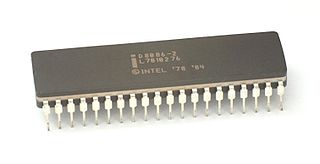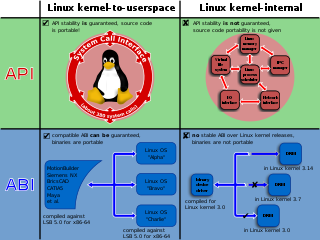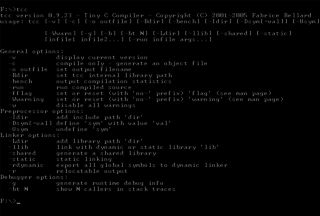
In computer programming, assembly language, often referred to simply as assembly and commonly abbreviated as ASM or asm, is any low-level programming language with a very strong correspondence between the instructions in the language and the architecture's machine code instructions. Assembly language usually has one statement per machine instruction (1:1), but constants, comments, assembler directives, symbolic labels of, e.g., memory locations, registers, and macros are generally also supported.
IA-32 is the 32-bit version of the x86 instruction set architecture, designed by Intel and first implemented in the 80386 microprocessor in 1985. IA-32 is the first incarnation of x86 that supports 32-bit computing; as a result, the "IA-32" term may be used as a metonym to refer to all x86 versions that support 32-bit computing.

x86 is a family of complex instruction set computer (CISC) instruction set architectures initially developed by Intel based on the 8086 microprocessor and its 8-bit-external-bus variant, the 8088. The 8086 was introduced in 1978 as a fully 16-bit extension of 8-bit Intel's 8080 microprocessor, with memory segmentation as a solution for addressing more memory than can be covered by a plain 16-bit address. The term "x86" came into being because the names of several successors to Intel's 8086 processor end in "86", including the 80186, 80286, 80386 and 80486. Colloquially, their names were "186", "286", "386" and "486".

The Netwide Assembler (NASM) is an assembler and disassembler for the Intel x86 architecture. It can be used to write 16-bit, 32-bit (IA-32) and 64-bit (x86-64) programs. It is considered one of the most popular assemblers for Linux and x86 chips.

In computing, a system call is the programmatic way in which a computer program requests a service from the operating system on which it is executed. This may include hardware-related services, creation and execution of new processes, and communication with integral kernel services such as process scheduling. System calls provide an essential interface between a process and the operating system.
Transmeta Corporation was an American fabless semiconductor company based in Santa Clara, California. It developed low power x86 compatible microprocessors based on a VLIW core and a software layer called Code Morphing Software.
A low-level programming language is a programming language that provides little or no abstraction from a computer's instruction set architecture; commands or functions in the language are structurally similar to a processor's instructions. Generally, this refers to either machine code or assembly language. Because of the low abstraction between the language and machine language, low-level languages are sometimes described as being "close to the hardware". Programs written in low-level languages tend to be relatively non-portable, due to being optimized for a certain type of system architecture.
x86 assembly language is the name for the family of assembly languages which provide some level of backward compatibility with CPUs back to the Intel 8008 microprocessor, which was launched in April 1972. It is used to produce object code for the x86 class of processors.
The x86 instruction set refers to the set of instructions that x86-compatible microprocessors support. The instructions are usually part of an executable program, often stored as a computer file and executed on the processor.
In computer programming, an inline assembler is a feature of some compilers that allows low-level code written in assembly language to be embedded within a program, among code that otherwise has been compiled from a higher-level language such as C or Ada.

The Tiny C Compiler is an x86, X86-64 and ARM processor C compiler initially written by Fabrice Bellard. It is designed to work for slow computers with little disk space. Windows operating system support was added in version 0.9.23. TCC is distributed under the GNU Lesser General Public License.
In the x86 architecture, the CPUID instruction is a processor supplementary instruction allowing software to discover details of the processor. It was introduced by Intel in 1993 with the launch of the Pentium and SL-enhanced 486 processors.
The Cyrix coma bug is a design flaw in Cyrix 6x86, 6x86L, and early 6x86MX processors that allows a non-privileged program to hang the computer.
VAX MACRO is the computer assembly language implementing the VAX instruction set architecture for the OpenVMS operating system, originally released by Digital Equipment Corporation (DEC) in 1977.
The task state segment (TSS) is a structure on x86-based computers which holds information about a task. It is used by the operating system kernel for task management. Specifically, the following information is stored in the TSS:
This article describes the calling conventions used when programming x86 architecture microprocessors.

C# Open Source Managed Operating System (Cosmos) is a toolkit for building GUI and command-line based operating systems, written mostly in the programming language C# and small amounts of a high-level assembly language named X#. Cosmos is a backronym, in that the acronym was chosen before the meaning. It is open-source software released under a BSD license.
A decompiler is a computer program that translates an executable file to high-level source code. It does therefore the opposite of a typical compiler, which translates a high-level language to a low-level language. While disassemblers translate an executable into assembly language, decompilers go a step further and translate the code into a higher level language such as C or Java, requiring more sophisticated techniques. Decompilers are usually unable to perfectly reconstruct the original source code, thus will frequently produce obfuscated code. Nonetheless, they remain an important tool in the reverse engineering of computer software.
VIA PadLock is a central processing unit (CPU) instruction set extension to the x86 microprocessor instruction set architecture (ISA) found on processors produced by VIA Technologies and Zhaoxin. Introduced in 2003 with the VIA Centaur CPUs, the additional instructions provide hardware-accelerated random number generation (RNG), Advanced Encryption Standard (AES), SHA-1, SHA256, and Montgomery modular multiplication.






